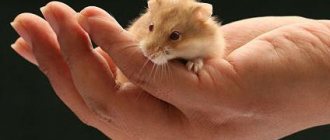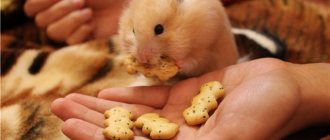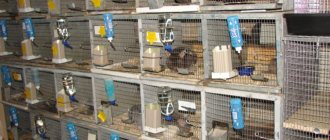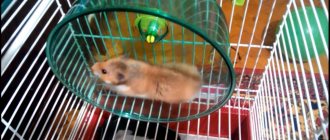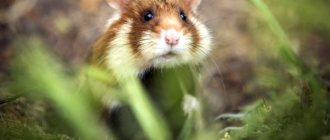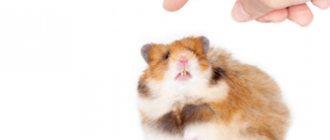- home
- Housing
15.04.2018
Difficulties with how to accustom a hamster to a water bottle usually arise with inexperienced owners. Even healthy and active animals refuse water in certain situations. This may be due to a change of environment or the purchase of a different drinker. If the rodent previously drank from a bowl, it may not pay attention to the new object in the cage. To find out the reason for the refusal, you need to observe your pet’s behavior throughout the day.
Do hamsters drink water?
Water is included in the diet of all living organisms. Hamsters are no exception. The rodent consumes a large amount of dry food. In order for his digestive system to cope with food processing, it is necessary to fully replenish the water balance.
In the natural environment
Dzungarik, Syrian hamster and many other varieties of these rodents are naturally found in fairly arid areas. They mainly live in steppes and semi-desert areas. The animals do not go to open bodies of water, but hide in burrows during rainy periods. They replenish their need for liquid with the help of dew. In winter, hamsters hibernate for a short time.
Important! A domestic hamster can live no more than two days without water. Some individuals can withstand up to a week, but this is fraught with disturbances in the functioning of the kidneys and digestive tract.
They leave it once a week to relieve themselves and eat. During the cold season, these animals store in their burrows reserves of food that does not spoil (root vegetables, grain, etc.). Hamsters satisfy their need for water in winter from underground sources and condensation on vegetables. Typically, their dwellings are located at a depth of at least 2 m underground, have several exits and separate areas for sleeping and eliminating needs, supplies and other needs.
When kept at home
At home, the hamster must have a drinking bowl in the cage. The fluid should be changed regularly and do not forget to replenish its reserves. If in the wild the animal has the opportunity to independently regulate its water balance, then when kept indoors this is the task of the owner. On average, one dwarf individual weighing 50 g absorbs from 2.5 to 7 ml of liquid per day.
The need to drink may be more or less depending on:
- from body weight;
- conditions of detention;
- diet: the more succulent food, the less the animal needs water.
Reasons for refusing water
First you should make sure that the animal does not drink. Djungarians need 2 ml of water per day, and the decrease in liquid from the container may not be noticed. Hamsters tend to quench their thirst at night, when the owner does not see it. If refusal to drink is beyond doubt, you should quickly understand why your hamster is not drinking water. This happens for several reasons:
- The pet simply does not want to drink. Juicy vegetables, fruits and greens in the diet can satisfy up to 98% of the animal’s water needs.
- The drinking container is fixed too high and the hamster cannot reach it.
- The drinking bowl is broken. In automatic designs, the ball of the drinking tube often jams, causing liquid to stop flowing.
- Stale drink. The unpleasant smell of water, which has not been changed for a long time, scares away the animal.
- A pet does not know how to drink from a drinking bowl - this is a problem for young animals who see the contraption for the first time.
If your hamster does not drink from the water bowl, although he used it skillfully before, you should think about visiting a veterinarian. A sudden refusal to drink when the device is working properly, the water is changed daily and the content of succulent food in the animal’s diet is low is a cause for alarm.
What kind of water should you give your hamster?
It should be remembered that you should only give your hamster water with clean water. You can give the key, boiled, bottled or from the cooler. Tap water that has not undergone heat treatment is not suitable. It contains chlorine and other impurities that can lead to the death of your pet.
Important! It is strictly forbidden to give hamsters carbonated water.
It is allowed to periodically replace the water with a special fortified drink for rodents from a pet store, and prepare a decoction of herbs. The water in the drinking bowl must be changed every 2-3 days and its quantity checked daily in order to notice changes in the pet’s behavior in time if it suddenly starts drinking less or refuses liquids altogether.
Instructions
The new pet must be allowed to get comfortable in the house and be allowed to explore the living conditions. When he calms down, he will begin to carefully study the cell. He may not need help in mastering drinking; after a while he will discover that he drinks without prompting. If this does not happen, you can accustom your hamster to the toilet, to the feeder and drinking bowl as follows:
- Let the animal into the house, do not touch or disturb it, after a while it will be able to find water and bury its face in it.
- If the rodent does not approach the device and does not drink, you can lightly poke its muzzle into the liquid and give it a drink.
- If the animal is wild and not yet accustomed to being handled, the nipple drinking device is lubricated with something aromatic. He can't resist the smell and starts licking it. If he does not do this, you need to slip the tip of the device under his nose and teach him how to use it.
How to accustom to a drinking bowl
There are different variations of drinking bowls. The most optimal design is automatic. It consists of a bottle with a cap screwed onto it with a tube at the end. The device must be filled with water and hung on the cage bars using a special metal holder. Liquid comes out of the tube automatically.
This sippy cup is easy to clean and the water in it does not splash in different directions. It is much easier to accustom a tame hamster to a drinking bowl, since it willingly makes contact with its owner. The water device must be installed in such a way that the animal can freely reach the water supply tube.
Algorithm of actions when familiarizing a hamster with a drinking bowl:
- Place a block of water.
- Watch the animal. When an unfamiliar object appears in the cage, the animal will definitely study it. During the familiarization process, rodents most often figure out on their own what exactly the device is for.
- If the pet has not shown interest in the water bowl, which is very rare, you need to pick it up and carefully bring it to the water supply tube. As soon as the animal notices a drop of liquid, it will immediately understand why the new object in the cage is needed. You can directly apply some water to the rodent’s nose with your finger.
Learn how to make your own hamster toys.
All types of hamsters are accustomed to drinking bowls in the same way. The difference is how adequately the animal reacts to human contact. Aggression in hamsters is completely independent of species. Of course, if a rodent has little experience in communicating with humans, it will experience fear and, accordingly, may bite. If you have not yet managed to tame your pet, then when accustoming it to a new water supply device, you should not touch it with your hands. In this case, in order to arouse the hamster’s interest, you need to lubricate the drinking tube with cucumber or apple juice.
You can use any other favorite pet treat. You should act in the same way if you are faced with the task of adapting the animal to communicate with yourself. They begin to tame the rodent gradually. To do this, put food in your hand and wait without moving until the hamster himself comes for the treat. So, after a couple of days, he will get used to the owner’s smell and will not feel danger. A little later, you can pick it up for 15 minutes, 3 times a day.
How to make your own hammock
You can make a hanging bed for your pet yourself in literally a couple of hours, if you know how to sew, weave or knit at least a little.
From felt boots
The easiest option to make with your own hands is a hammock made from felt boots. It is enough to sew ties, straps, chains or carabiners to the felt boots (they can be cut from a worn-out backpack or old bag) so that the boot after hanging remains in a horizontal position, and the toe “looks” up. If desired, several small pockets can be sewn to the outside of the boot in which the ferret will hide his finds.
From a piece of fabric
Another simple option is a hammock made from a piece of fabric made by yourself. To make it you will need dense, soft and preferably natural fabric, it can be drape, denim, cashmere, thin felt, thick linen, etc.
You can also use fleece or faux fur, it is important that the material does not emit a strong odor, otherwise the animal will not use the hammock
The scrap of fabric for the base of the hammock is folded right sides inward and sewn on three sides (by hand or on a sewing machine). Next, the workpiece is turned inside out and the hole is sutured, tucking the cuts inward.
The blanks for the ties are folded in half lengthwise, right sides inward, and stitched with a 0.5 cm indentation from the cuts along the long side. The blanks are turned inside out, helping yourself with a pencil, short sections are tucked inside and sewn up. The finished ties are firmly sewn to the corners of the hammock base.
Tip: if you don’t want to bother with ties, you can use ready-made straps, chains, carabiners or dense cords such as paracord instead.
Hammock pillow
A hammock-pillow is made in almost the same way as a fabric hammock, only you need to take slightly larger scraps of fabric as a basis (at least a square with a side of 35 cm), and after turning the main part of the hammock inside, put foam rubber, rustling balls, or loosely stuff the workpiece with padding polyester, and only then sew up the fourth side. A hanging bed can be supplemented with a secret pocket by sewing another piece of fabric the size of the base to the pillow. In this case, the pet will be happy to “dive” inside this pocket and hide its “prey” in it.
Hammock tube
It’s easy to make a hammock-pipe with your own hands. Two rectangular pieces of fabric measuring approximately 40x60 cm and a piece of thin foam rubber or dense padding polyester slightly smaller than the fabric pieces are folded into a “sandwich”: the first piece of fabric is face down (on the table), a pad is placed on it, and the second piece of fabric is placed on top with the wrong side to the gasket. The “sandwich” is fastened with pins and stitched around the perimeter, tucking the sections of tissue flaps inside. If desired, quilt the entire surface of the workpiece. Next, the workpiece is rolled into a pipe along the long side, and the edges of the pipe are overlapped. Then sew ties and, if desired, pockets to the sides of the pipe and a piece of faux fur to the bottom from the inside.
How to feed a hamster if there is no drinking bowl
Every animal has its own unique character, just like humans. When keeping hamsters, situations may arise when there is no automatic drinking bowl or the rodent fundamentally refuses to take water from it. In such cases, a regular food bowl intended for rodents or a nylon lid will come in handy.
Did you know? Baby hamsters are born blind and naked, but they immediately have teeth.
True, with this type of drinker there will be many more problems. Feces, food and bedding fractions constantly get into the open container, so the liquid will have to be changed several times a day. In addition, there is a high risk of water overflowing and your pet’s fur getting wet, which is not desirable for him. But such a drinking bowl is the easiest to clean.
Will a hamster drink water from a bowl?
Whether you can get a hamster to drink from a bowl depends entirely on its temperament. In principle, a hamster is quite capable of absorbing water from this type of drinker. Of course, this is not a cat and he won’t be able to lap up the liquid. The animal will have to get moisture from the bowl using its paws. Typically, rodents sit next to the container, plunge their forelimbs into it and lick the water from them.
In general, such drinking bowls are used very rarely due to the frequency of their maintenance, or they are used as temporary ones, for example, when the cage is being cleaned and disinfected, and the animal is placed in a temporary shelter.
Actions to take if your pet is in an unnatural condition
Sometimes hamster owners notice strange behavior in their pets. These include frequent and heavy drinking, refusal of food and water, and other symptoms. If there is no improvement in the animal’s condition within two days, you should consult a veterinarian.
Doesn't drink or eat
In severe illnesses, the rodent refuses to eat and drink, which leads to exhaustion and dehydration. To avoid this, it is important for the hamster owner to know what to do if the animal does not drink water from the drinking bowl and does not eat. In this situation, you often have to force-feed your pet using a pipette or an insulin syringe without a needle. It is necessary to pour water into the animal’s mouth in small portions that the rodent can easily and quickly swallow. You can't put your hamster on its back.
Drinks a lot
The reason for increased thirst is the lack of succulent food in the animal’s diet. It is worth reviewing your pet’s diet and including more fresh fruits and vegetables. If after this the situation has not changed and the animal still drinks a lot, this is a sign of illness. One such disease is diabetes, which is common in dwarf hamsters.
The automatic drinking bowl will help the animal quench its thirst without difficulty. It is worth spending a few days teaching your hamster to drink from a water bowl. There is no need to worry if your rodent doesn't drink enough. A good appetite and active pet will make it clear that there is no reason to worry.
Types of drinking bowls: advantages, disadvantages, features
Nipple
The most affordable and common option. This is a small container with a straw. There is a nipple installed inside the tube - a special ball on a spring. The structure is suspended from the cage rods. When an animal wants to drink, it approaches the drinking bowl and presses the ball with its tongue. The nipple is activated and a small amount of liquid is released into the mouth.
- nipple drinker saves space in the cage;
- easy to use;
- safe for the hamster;
- Only clean water comes out of the container, without plaque or rust.
It is difficult to teach a hamster to be independent, especially to press a ball. The main drawback appears: not all animals will like the nipple drinker.
From a whole bottle
A simple and inexpensive water bottle for your hamster. The design consists of a plastic or glass bottle and a straw. The device is suspended inside the cage or from behind. Fresh, clean water is available to the animal at any time.
- production does not require special skills and knowledge;
- The bottle is easy to wash and clean;
- dust and dirt do not get into the container;
- The animal is healthy and feels great.
As with the previous form, there is one key drawback - the hamster needs to learn how to use such a drinker.
From a cut bottle
This type of drinker involves cutting the bottom of the bottle. The structure is suspended from frame rods from the rear. The pipe is pushed between the rods into the house. The device works on the principle of drinking from a whole bottle.
- simple production requiring a minimum amount of materials;
- water is easy to change;
- the animal will not be injured by the cut edges of the bottle.
Disadvantages include difficult training of the rodent and poor hygiene of the device. Dust and detergent particles will get into the liquid. There is a risk of pet poisoning.
Sippy cup from a pet store
Purchased containers will last much longer, unlike homemade ones. The cost of nipple attachments varies from 100 to 250 rubles. Automatic accessories are more expensive - from 250 to 700 rubles. There are branded models whose price is more than 1000 rubles.
One of the significant disadvantages of a drinking mug for a pet store is defects. Every third person buys a low-quality product. An additional disadvantage of purchased goods is the refusal of the sellers to accept the goods back. For example, if the cup is damaged or does not fit.
Important! Before purchasing a drinking cup, it is carefully checked for integrity or functionality. For example, water supply mechanisms often do not work with nipple or automatic fittings. There should be no chips or cracks on the body.
Floor drinking bowls
Place in a cage on the floor or on a stand. The drinking bowls look like a deep, heavy bowl. The hamster has access to water 24/7, the bowl is easy to clean, and the water can be changed quickly.
The main disadvantages of the floor product are instability and constant water pollution. The person spends a lot of time cleaning the cage, but the hamster drank only cool, body-safe water.
Drinking bowl with pocket
This design consists of a water container and a lid with a pocket spout. The hamster drinks only the water that it collects in its pocket. The water supply to the tank always remains clean. The drinking bowl is installed in the cage. It has the following advantages:
- hygienic;
- easy to use;
- reliable and durable;
- It is difficult for a hamster to pour water from a drinking bowl.
The disadvantage of the drinking bowl is that the liquid in the pocket gets dirty as soon as possible. During active play, rodents throw sawdust into the drinking bowl. If you don’t clear your nose in time, the animal will be left without anything to drink.
Vacuum drinking bowl for hamster
Installed in a cage. Looks like a bird feeder. The container is placed in a deep bowl. Water is served in small portions. Hamsters quickly get used to the design due to its ease of use. The accessible drinking portion is rarely contaminated.
The disadvantage of a vacuum drinker is the material used. Animals easily chew through soft plastic.
Automatic sippy cups
They are divided into two types: ball and nipple. Flasks are made of plastic or glass. There is a tube at the end of the container. The drinking bowl is attached to the outside of the cage and serves as a washbasin. The design is removable and easy to clean.
The main disadvantages of an automatic device are defects and the need to teach the hamster to use its nose.
Do hamsters need water and how long can they live without it? How to train a hamster to drink from a bowl and what kind of water is best to choose? What else do pets drink, do they drink milk?

